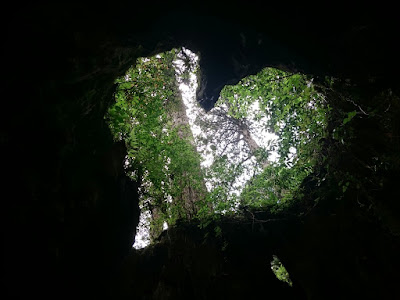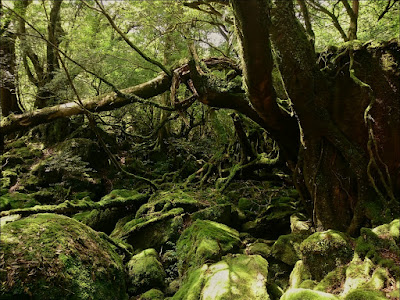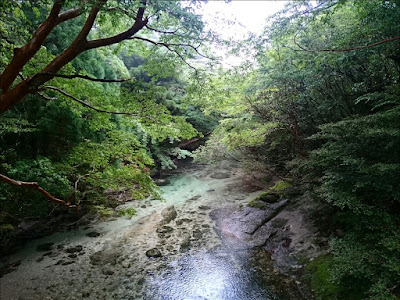I'm afraid I have some bad news for you.
My loyal travel companion - an Xperia Z3 - died the day before yesterday after taking a swim in the sea :'(.
Thankfully I was able to save all of my data, so the loss is not that grave. It does however have consequences for this blog.
Not only was my smartphone the device on which I wrote all of my posts, but also the camera that took all of the uploaded pictures.
Although a smartphone was never the ideal tool for writing a blog, the alternatives I am left with are even worse.
Uploading content, especially pictures, has now become considerably more difficult for me and I thus won't be able to write new posts with the same frequency as in the past.
We'll see what the future brings, as for now though I won't make any promises.
Japan - Our Travel Blog
Search This Blog
Thursday, 18 June 2015
Monday, 15 June 2015
Yakushima - The Forest of Wonders
Hello everyone
I'm sorry to have made you wait so long for some news.
As of late I haven't necessarily had much time to my disposal and, as you might notice, this following post required quite a lot of work.
It covers my stay five day stay in Yakushima and offers a generous amount of detail and insight.
I hope you'll enjoy it.
At the moment we are in Okinawa, where the unbearable heat and humidity have lowered our curiosity and productivity so much that we barely make it to the beach anymore and instead prefer to spend our time in the pleasantly air conditioned refuge that is Starbucks.
This is only half of the truth of course, as you will find out in the next post.
As for now, please let me introduce Yakushima to you:
Fun facts about Yakushima:
- Yakushima is the wettest place in Japan and one of the wettest in the world. Locals say that it rains 35 days a month.
- Yakushima is Japan's southernmost point where it snows in winter.
- There are more deer than people living in Yakushima.
- Yakushima served as inspiration to Hayao Miyazaki's film "Princess Mononoke".
- Tekken's Jin Kazama was born and raised in Yakushima.
Although I had read up all the literature and gone over every map I could find, many things about Yakushima were still unclear to me.
When I left Hagi all I had was an accommodation for the first night and a rough sketch for the two day hike I intended to do. I was oblivious however of the island's public transportation system, the course of the maintained hiking treks, and the location of the mountain huts.
This would be quite the adventure, it seemed.
Before I could go to Yakushima I would have to spend a night in Kagoshima and then take the ferry the next morning.
04.06.15
The first impression I got was that of a relaxed and vibrant town of an almost Mediterranean charm. The wide streets were packed with cheerful people who were either shopping, drinking coffee in one of the many cafés, or playing golf by the canal.
While stopping to take a picture of the volcano smocking away in the distance, I was approached by an elderly man calling "herro, herro".
He was delighted that I had chosen to visit Kagoshima and asked me if I knew anything about its history. Since I was completely ignorant, he offered to give me a short lecture.
He proudly explained that Kagoshima was a city of national importance.
Not only was it one of the main stages of the Meiji restoration, but also the birth place of Saigo Takamori, a politician who played a major role in the process of transforming Japan into a modern state that could compete with the western superpowers.
Almost hurt by the fact that I had never heard that man's name before and knew close to nothing about the Meiji restoration, he took me to a museum, telling me that I had to "go and learn".
I followed his advice and so should you:
http://afe.easia.columbia.edu/special/japan_1750_meiji.htm
Later on I headed to the guesthouse right by the harbour which, for the first time during my stay in Japan, was close to being fully booked out.
There I met Tetsuya, who had just come back from Yakushima.
He helped me polish my sketchy hiking route, told me what gear I would need on my two day excursion and by what time I had to arrive at the mountain hut in order to get a sleeping spot. He also gave me the bus's timetable as well as a map with all of the hiking trails and mountain huts and taught me the two sentences I would need:
xyz ni ikkitai. - I'd like to go to xyz.
Tasukette kudasai! - Please help me!
05.06.15
Long before my alarm would have rang I was woken by Tetsuya, who had bad news for me.
A storm had come up over night and there was now heavy rainfall and a strong wind that would lead to rough, or even dangerous conditions at sea.
He therefore did not believe the ferry would operate this day and he wanted to give the company a call to see if his suspicions were right. As he didn't get through however, I had to head out into the rain and find out for myself.
I was in luck.
The ferry did leave for Yakushima this day - for the last time before it would go under for maintenance for two weeks!
There were only a few other passengers on board and as none of them seemed very talkative I decided to get some sleep.
The welcome Yakushima gave me after the four hour ride was not a warm one.
It was still raining like mad and it quickly became very obvious that my raincoat was not as waterproof as it once used to be.
Completely drenched I arrived at the closest sports gear rental shop where I grabbed a pair of hiking boots, a sleeping bag, and a hopefully waterproof rain suit.
I then bought the provisions necessary for my two day hike, packed my rucksack and made myself familiar with the itinerary.
I'd be taking the first bus in the morning from Miyanoura to Shiratani Unsuikyo, from where I'd hike all the way up to Kusugawa Crossroad. I'd arrive around noon and then continue to the Shin-takatsuka hut, my accommodation for the night. In this phase I would get to see the Wilson Stump and the Jōmon sugi, two of Yakushima's most famous landmarks.
On the next day I would climb Miyanoura-dake, Yakushima's highest mountain. After the descent I'd arrive at Hananoego and from there on move to the entrance of Yakusugi Land, from where I'd take a bus to Anbo
I enjoyed a light supper by the harbour before having an early night.
06.06.15
The bus arrived eight minutes too early and I just barely managed to catch it.
It was loaded with a Japanese tourist group, consisting mostly of elderly people.
This was not exactly what I was hoping to run into and I wanted to outdistance them as soon as I could, which should not be too much of a problem. Indeed, after only fifteen minutes I had left them far behind and was now able to fully enjoy the hike and take in the surroundings with no other human soul around.
I had immersed myself in an ancient forest of unmatched beauty and unlike anything I had ever seen before. The trees had trunks the size of a tractor's tyre and rose high up into the sky. Where the ground wasn't entirely overspread with roots, it was coated in thick moss or foliage.
The only audible sounds were those of birds tweeting, crickets chirping, or a river rustling and the humid air was filled with thousands of different scents and smells.
If you were lucky enough, you would come across wild deer, the Yakushika, or even spot a monkey, the Yakushima Macaque.
 |
| At a certain angle the outlines of the Wilson Stump's trunk will form a heart ♥ |
 |
| The famous Jomon-sugi: It is said to be somewhere between 2200 and 7500 years old! |
If you were lucky enough, you would come across wild deer, the Yakushika, or even spot a monkey, the Yakushima Macaque.
I was one of the first to arrive at the Shin-takatsuka mountain hut, but it quickly filled with other hikers who had taken different trails.
The atmosphere at supper was very joyful and although tired, everyone did their best to keep the spirits up.
I tried to have an early night, haunted by the prospect of getting up at 4:30 the next morning, but the hardness of the naked wooden floor and snoring of the others would keep me awake for hours to come.
07.06.15
Although I had hardly slept, I felt fit for the hike and by 5:00 a.m I was on my way to Miyanoura-dake Peak, just in time to catch a glimpse of the first sunlight to pierce the dense treetops.
The higher I climbed, the more the landscape changed and the more it started to look alpine, reminding me even a little of Switzerland at times.
With a height of 1'935 metres Miyanoura-dake is Yakushima's highest elevation and according to my itinerary I would make it to the peak at around 10:00 a.m.
Yet for some reason I was ahead of time and by 9:00 a.m I could already savour the magnificent views that it offered.
Yet I also saw dark, menacing clouds in the south, approaching at a worryingly fast pace and laden with rain.
I thus hurriedly unpacked my rain gear and carried on with the hope of reaching the forest before the rain set in.
Despite my precautions I was soaked only half an hour after it had begun to rain, my rented rain suit proving itself just as worthless as my own.
That set aside, I was enjoying the descent and made it to the bus stop without any further incidents, even being able to have lunch under the shelter of the Yodogawa hut.
When I arrived at the guesthouse in Anbo I was wet to the bone, shivering with cold and in desperate need of a hot shower.
After I had had my shower and got into a dry set of clothes, my two roommates entered.
They introduced themselves as Koki and Keita and wanted to know if I had already had supper. The many shika they had seen on their hike had stimulated their appetite and they were now eager to find out what they tasted like.
I replied that I was dying for a warm meal and would love to try some shika meat too, upon which they took me out to a restaurant across the street where we ordered a large plate of shika meat, diced up into little pieces and served with onions, lotus root, and vegetables.
It was a true feast with a lot of talk and laughter that would have probably gone on for hours, had it not been for my booking of the "turtle viewing" on that very evening.
I was taken aback when they took charge of my bill and I insisted that I pay myself.
They wouldn't take no as an answer though and told me that this was omotenashi, the spirit of Japanese hospitality.
 |
| From left to right Keita and Koki |
When we got back to the guesthouse, my guide Aise was already waiting for me.
She drove me to the protected beach in the north of Yakushima where each night only a few selected people were allowed to enter.
For about an hour I watched a Loggerhead turtle lay her eggs into a hole in the sand, for which she would later make a considerable effort to cover up and meticulously camouflage before she returned to the sea.
This might not sound very exciting at first, but it is in fact a very moving thing to see.
Sea turtles are really fascinating creatures and I learned many interesting facts about them that night If you want to know more about this endangered species, I highly recommend you watch this excellent BBC video on Youtube: http://youtu.be/wW7QikBvrWI
08.06.15
The course on "shower climbing" that I had booked for this day was unfortunately cancelled due to the heavy rainfall of the day before.
As an alternative my local guide took me river kayaking and, when the weather got worse, drove me around the island to show me some of its many waterfalls.
Since he was born and raised on Yakushima he knew a great deal about the island and was able to tell me the name of each river, waterfall, animal and plant we passed by.
|    |
| The Ohko-no-Taki waterfall |
It also meant that his English was very limited, but we still managed to understand each other somehow and if everything else failed, we filled the silence by singing the best known hits of Santana, The Beatles, and Bob Dylan.
This evening I had sushi for dinner at a nice local restaurant by the river.
There I met Michiko who had arrived shortly before me. She immediately apologised for her poor English, noting that she had "a bad brain that not know English but want to learn".
She had come to Yakushima because she loved the outdoors and wanted to do some hiking in unspoilt nature. When I told her that I was from Switzerland, a hikers paradise, her eyes went wide and she exclaimed that she had "a great admiration to go to Switzerland".
09.06.15
On this day I visited Yakushima's Botanical Research Park, which lay on the way to my next guesthouse.
I spent a good two hours examining exotic plants from different corners of the earth and enjoying the splendid views of the sea and the Torohki-taki waterfall.
Right before I arrived at the guesthouse I came across Hikaru and Haruyo, an extremely friendly couple from Anbo.
They were exploring Yakushima by car and asked me if I wanted to go with them. As I had no plans for the afternoon I thankfully accepted their offer and thus got another tour around the island that was a lot more fun this time around, even if less informative.

10.06.15
This would be my final day on the island and before I left I wanted to stop by the café where Haruyo worked. It is called Smiley and well known among locals for its homemade cakes, wide selection of hot beverages and homely atmosphere.
While I was drinking my coffee and watching the ships pass, it dawned on me how quickly my time in Yakushima had gone by and I was hit by a sudden wave of melancholy.
Never before had I been met with so much hospitality and selflessness as I was on this island. The kind and warmhearted character of the locals contrasted with the beautiful, yet unforgiving and at times even brutal nature of their environment.
It was very touching to see how attached everyone felt to their home and how much effort they put into protecting and preserving it, so that future generations could relish the marvels and wonders of this magical place.
At the harbour I bumped into Hikaru who had come to see me off.
He thanked me for my company the day before and wished me safe travels, handing me the homemade biscuits he had brought along as a farewell gift.
Subscribe to:
Comments (Atom)


























































